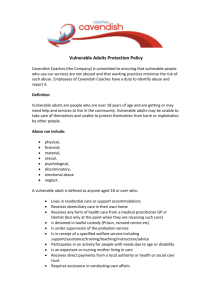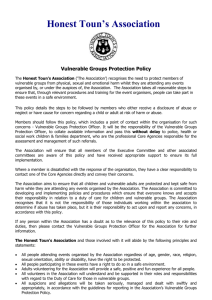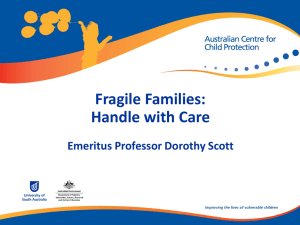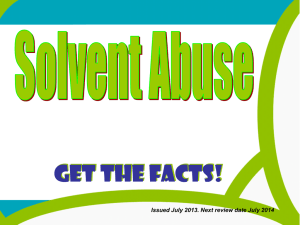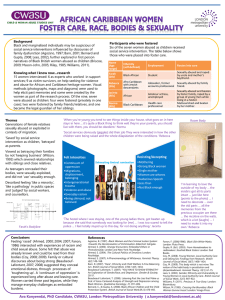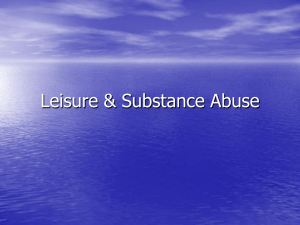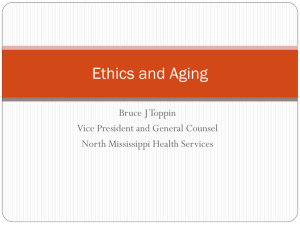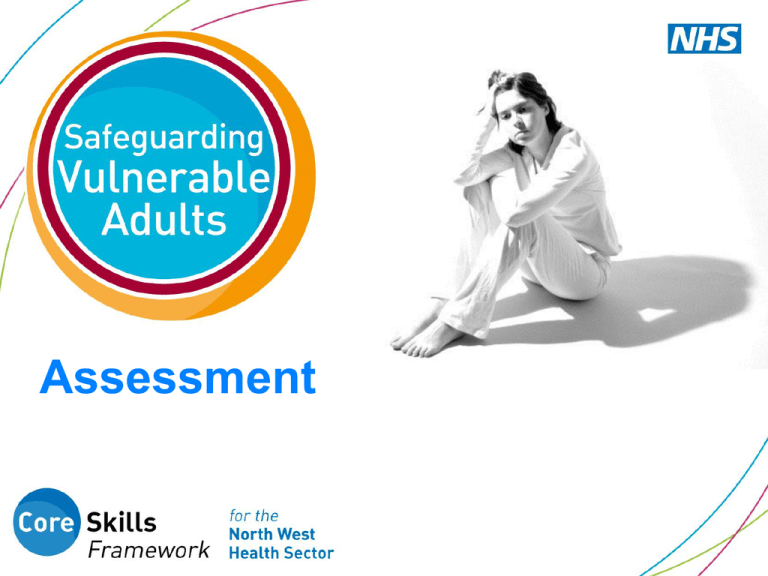
Assessment
1. Legally, abuse only occurs when
the abuser intends to cause harm
1. True
2. False
50%
1
50%
2
Correct Answer is 2 - False
• Abuse can be unintentional. Negligence or
ignorance can lead to abuse without anyone
meaning to. Similarly, abusers are not necessarily
bad people. They may be victims of circumstances
and need help and support themselves.
Nevertheless, for the individual who is experiencing
abuse, the intention of the perpetrator is not that
relevant. That’s why, if you suspect abuse (whether
it appears to be deliberate or not), you need to report
it to ensure that appropriate actions are taken to
protect the victim.
2. At what age may an individual
be classed as a “vulnerable adult”?
1. 16 and over
2. 18 and over
3. 21 and over
33%
1
33%
2
33%
3
Correct Answer is 2 – 18 and over
A ‘vulnerable “adult’ means a person aged 18
or over. It is exactly the same for all groups,
regardless of any disability, emotional state
or physical characteristics.
3. You suspect that someone is being abused.
At which stage should you report the abuse?
1. When you have acquired
evidence
2. Straight away
3. After you have discussed
the situation with
colleagues
4. You shouldn’t, suspicions
aren’t enough to warrant
reporting abuse
25%
1
25%
25%
2
3
25%
4
Correct Answer is 2 - straight away
If you ever suspect that someone is being abused, you should
report it whether you have evidence or not. Don’t keep
suspicions of abuse to yourself, but avoid talking about it with
colleagues as this may jeopardise any inquiry, as well as
undermine the privacy and rights of both the vulnerable adult and
the alleged perpetrator. Referring your concerns to the
appropriate adult protection team or individual means that
information can be logged and decisions made regarding any
action that should be taken. Remember that it is not your job to
gather evidence. Indeed, by trying to get further information of
abuse, you can put yourself or the vulnerable adult at risk.
4. If you suspect adult abuse in the workplace,
who might you report this to?
25%
1.
2.
3.
4.
25%
25%
2
3
25%
Designated safeguarder
Police
Social services
Any of the above
1
4
Correct Answer is 4 – Any of the above
Normally, suspicions of abuse would be reported
to the designated individual or team responsible
for safeguarding. However, in some
circumstances you may need to report this
elsewhere. If you witness or suspect that there is a
risk of immediate harm to a person you must act
immediately to protect their safety. In this
instance, you may need to contact the police. You
are also entitled to report potential safeguarding
issues directly to social services if you wish.
5. If you suspect an adult is being abused, in what
circumstances would sharing information with an
appropriate person without the individual adult’s
consent be justifiable:
50%
50%
1. It is only justifiable if
there is evidence that the
individual is suffering or
is at risk or suffering
significant harm
2. It is justifiable to share
information in every
circumstances, with or
without consent
1
2
Correct Answer is 1 – it is only
justifiable if there is evidence that the
individual is suffering or is at risk of
suffering significant harm
You should always obtain consent if possible.
However, in very exceptional circumstances,
disclosure without their consent may be justified if
you believe someone may be at risk of harm and
you are acting in their best interests. These
decisions are often complex and you must assess
each situation carefully.
6. Karl is a fit and healthy 35 year old man who is
in hospital for a minor, privately funded cosmetic
surgery. Which of the following is true?
25%
1.
2.
3.
4.
25%
25%
2
3
25%
Karl is not a vulnerable adult at
this point in his life
Karl is a vulnerable adult whilst
he is in hospital
Karl’s condition does not make
him vulnerable, if it was more
serious he would be
Private patients do not have the
same rights as other patients in
state-funded healthcare
1
4
Correct Answer is 2 - Karl is a vulnerable
adult whilst he is in hospital
As a healthy man, Karl is not the stereotype of a
vulnerable adult, but it is important to recognise
that anyone who needs care is vulnerable at that
time. Hence, all patients need exactly the same
protection
7. Someone who is being abused may not tell
anyone because they are ashamed
50%
50%
1. True
2. False
1
2
Correct Answer is 1 - true
It is a sad fact that many people who are abused are
ashamed of their situation or themselves. The nature of
some abuse may mean that victims come to see the abuse
as being their fault. As a result, they might think that no-one
would believe that or that they don’t deserve help. There are
other reasons why a person may not disclose abuse. They
may be afraid of punishment or believe that they will be put
in an institution. That’s why if someone does overcome
these feelings and tell you, you must report the allegation to
ensure that they get the help that they need. You might be
the first person they’ve told. If you don’t act, they may not
feel able to tell anyone else in the future.
8. Which of the following would constitute
discriminatory abuse?
1.
2.
3.
4.
A group of friends laughing at a
racist joke on youtube
A colleague avoiding talking to
someone because he is scared of
them
A nurse refusing to provide
reproductive advice to a lesbian
because her religious belief is that
gay people should not have
children
A male colleague believes that
women are worse drivers than
men and that female paramedics
should not be allowed to drive
ambulances
25%
1
25%
25%
2
3
25%
4
Correct Answer is 3 - A nurse refusing to provide reproductive
advice to a lesbian because her religious belief is that gay
people should not have children.
Discriminatory abuse is when someone picks on a vulnerable adult or treats them
unfairly because something about them is different, such as:
Clothes
Weight
Race or skin colour
Religion or culture
Being a man or a woman
Being a gay man or a lesbian woman
Their age
Problems with their health or disability.
Hence, only C is discriminatory abuse it is unacceptable to refuse care on these
grounds, whatever beliefs the individual has. The key issue here is that the
individual was not able to access their rightful services. In answers 1 and 4 there
is evidence of potentially discriminatory views, but there is no legislation on what
people should think. It is actions that matter. In answer 2, there is too little detail
on why the individual was scared – they may have very good reason to be.
9. Someone discloses to you that they are
being abused.
What should you do?
25%
25%
25%
2
3
25%
1. Reassure them that they
have done the best thing and
are safe now
2. Document the incident as
soon as you can
3. Find out from your
colleagues if they know of
anything
4. Tell your boss
1
4
Correct answer is 2 - Document the
incident as soon as you can
It’s important that you report the situation as soon as you
can. Follow your organisation’s reporting guidelines and
don’t tell anyone else who doesn’t need to know. Good
reporting is about providing accurate documentation, so it
is vital that you accurately note what you were told whilst it
is still fresh in your memory. After all, you may be called
upon to explain this at a later date. Try and be as
reassuring as you can when an individual is telling you their
story, but remember not to make promises to them that you
can’t keep.
10. Which of the following would be
seen to be a ‘vulnerable adult’?
33%
33%
33%
1. A sex worker
2. An 85 year old woman
who lives on her own
3. A person in need of
community care services
1
2
3
Correct Answer is 3 - A person in need of
community care services
The term vulnerable adult is used by the home office to
describe ANYONE who is, or may be:
• in need of community care services because they have
a mental or other disability, age or illness’
• unable to take care of him or herself.
• unable to protect him or herself from harm or
exploitation
• the people described in answers 1 and 2 MAY be
vulnerable, but this does not mean that they can’t look
after themselves.
THANK YOU
End of the assessment




